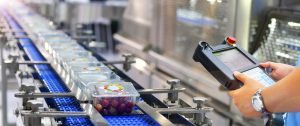This blog generally examines technology and economic trends for “hard goods” industries like Transportation, Life Sciences, or Aviation and Defense. The Consumer Packaged Goods (CPG) industry is rapidly becoming as technology savvy as any other manufacturing segment.
The CPG industry is generally defined as the manufacture and sale of items that require routine replacement or replenishment, including food, beverages, cosmetics and personal care, and household products. Competition is stiff, and margins are usually thin except in luxury brands. Consumer loyalty is hard to earn and worth the effort to maintain. In 2020, despite the pandemic, global CPG revenue was $1.9 trillion.
Supply chains were stressed in 2020, just as in other industries. Ingredients were sometimes in short supply; logistics were often disrupted, and consumer preferences shifted. Issues common to other manufacturing segments, such as sustainability, competition, and regulation also impact CPG. In addition, there are issues unique to the industry. What follows are some key trends impacting various CPG segments.
Riding the Lipstick Effect
The Cosmetics and Personal Care market is more resistant to economic downturns than most discretionary CPG categories. You can credit “the lipstick effect” for that. A theory first stated in 1999 by Professor Juliet Shor, the lipstick effect hypothesizes consumers will indulge in prestige cosmetics during tough economic times because they are “little luxuries” providing an emotional lift when the purchase of higher-priced goods is postponed.
To seek competitive advantage, market leaders in the segment are turning to advanced scientific tools like artificial intelligence and machine learning, to mine their own data and find rich areas of exploration. Such fierce competition and increased use of digital innovation has pushed Cosmetics and Personal Care R&D to leverage these advanced tools to discover new consumer benefits for their products.
Merging of Health and Beauty
The COVID-19 pandemic “has challenged beauty markets like never before,” notes industry research firm Mintel. It notes Cosmetics and Personal Care companies have launched initiatives on face-mask-friendly cosmetics and skin care; aligned with immunity support research in other fields; and increased research on hand care for both skin care and hygiene benefits.
Sustainable Packaging for E-commerce
Consumer behavior shifted during the pandemic; e-commerce retail achieved the equivalent of 10 years of growth during three months in 2020. Traditional retail channels require packaging that informs or entices the customer. Such packaging is not needed in e-commerce, where the sale has already taken place. The unintended consequence of this shift is the rise in products damaged when being shipped direct to the consumer.
Products shipped to retail stores go through a relatively ‘low-touch’ journey. Products ship in full cases on trucks and are offloaded in a store and placed on shelves. The e-commerce channel, on the other hand, is extremely ‘high-touch’ and rough on packaging. Not only does it often not adequately protect the product, but e-commerce consumers find it frustrating to throw away excess unneeded packaging designed more for enticement than shipping.
Everyone agrees e-commerce requires more sustainable packaging, tailored for the market. This is not a one-dimensional issue of simply upgrading unrecyclable plastic, for example. Packaging for sustainability impacts and is impacted by several other trends, all of which require thoughtful response from CPG companies.

“There has been limited progress … on reducing the need for single-use packaging altogether,” notes the Ellen MacArthur Foundation in a report on sustainability entitled The New Plastics Economy: Reuse Rethinking Packaging. “Progress on shifting toward reusable packaging is limited, and elimination efforts remain focused on a relatively small set of materials and formats.”
Clean, Natural, Sustainable, Personal
A majority of CPG consumers are drawn to products they believe match four buzz words: Clean, Natural, Sustainable, Personal. The genres are similar but not synonymous. “Clean” refers to products that are perceived as healthy and free from “bad” ingredients. “Natural” means a product is 100% derived from sources found in nature with nothing artificial added. “Sustainable” refers to how product ingredients are sourced, including the packaging. “Personal” is more subjective; consumers want products that positively reflect their age or personal reality (cellulite, tooth gaps, scars, gray hair, wrinkles, etc.).
The Quest for Alternative Proteins and Milks
A major shift is taking place regarding interest in alternatives to traditional animal proteins and dairy products. Only a few years ago the only alternative to meat and dairy were a few soy products created for the vegetarian market. Now mainstream supermarkets carry a wide variety of animal protein and dairy alternatives. The poster child for this shift is the Impossible Burger, which rapidly moved from novelty to fast food mainstay.
Emergen Research cites a variety of drivers behind this transition. Food preferences are changing; there is greater interest in preventing or reversing lifestyle-related diseases; disposable income is rising; and there is increasing moral and nutritional interest in the Vegan lifestyle, which eschews the use of all animal-origin products, whether for eating or as clothing, furnishing, etc.
Environmentalism is another strong driver for replacing animal proteins. Some activists claim large-scale animal protein production is a wasteful use of natural resources when compared to the environmental impact of plant-based protein production.
Value-added Distribution Networks
The food business grew in the past 40 years by consolidating into large producer/distributor operations, centered on creating a commodity-oriented distribution system. More recently technology and changing food habits are fueling the rise of specialized, integrated, and value-added production and distribution networks.
Niche products and new categories, such as kombucha drinks and plant-based faux meats, are only the tip of the iceberg. The entire food

supply chain needs a refresh, to become connected, transparent, efficient, and sustainable. These overarching goals are the same in other industries, which means there are lessons to be learned from other large industries already started down the road of creating more sustainable supply chains. Some in the business may view this shift as a challenge, but to those who can embrace tech-enabled forward thinking, rebuilding supply chains is a growth opportunity.
Iterative collaboration
Capturing scientific data in a common technology framework makes it easier for R&D in all CPG segments to apply cutting-edge technologies like 3D modeling, machine learning, simulation, and predictive analysis. Teams can virtually design products and optimize formulations by screening for the best combinations, creating a framework of iterative collaboration that leads to reduced development costs and accelerated innovation. Researchers can focus their knowledge and know-how on scientific innovation at the molecular level, collaborate and improve decision making by automating the scientific analysis of data from different research areas, and rapidly exploring, visualizing and reporting their research results in one digital environment.
##
Editor:
Join Dassault Systèmes at PACK EXPO Las Vegas and Healthcare Packaging EXPO 2021 taking place September 27-29. Stop by Booth #SU-8345 and SU-8444, and learn how to design, validate and make sustainable packaging faster – with the virtual twin. Register here and receive a free exhibition pass from Dassault Systemes.
Discover this free infographic detailing how virtual twin technology can be the most sustainable path to a circular packaging economy.